
Ripe and unripe Kousa Dogwood fruit. Photo by Green Deane
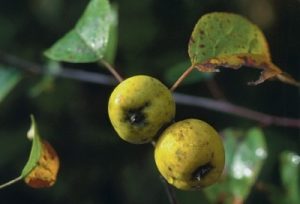
Wild Apples can be bitter. Photo by Green Deane
Kousa Dogwood, Sassafras, Wild Carrots, Birches, Apples… all species that don’t grow locally or are difficult to find but are common in South Carolina where I have classes this weekend. Wild Apples are particularly interesting. Every apple seed is totally different than the parent tree. There was only one “Granny Smith” apple tree. One Golden Delicious. One MacIntosh tree. They were cloned to make a commercial crop. That can take decades, a century in the case of the Granny Smith originally from Australia in the 1800’s. There used to be thousands of different apples on the market (and plums.) Mechanical farming a century ago diminished those. And if the Wild Apple you find is bitter don’t despair: Bake or roast it. That often makes them sweet. You can read about Wild Apples here. By the way one of the odd thing about Birches is that folks who have an allergy to Birch often have an allergy to bananas, or the reverse: Those with an allergy to bananas are often allergic to birches. A video on Sassafras is here.
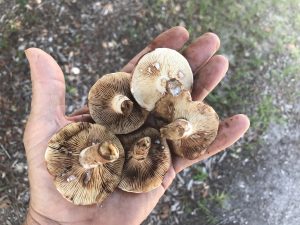
Lactifluus luteolus, an edible Milk Cap. Photo by Green Deane
As one might infer the rains of late have caused a widespread mushroom flush. I started and moderate five Facebook pages on mushrooms. Those pages are getting thousands of posts. Among the edibles are chanterelles, boletes, various milk caps and some of more exotic ones such as Jelly Fungus (snow and wood ears.) At the same time toxic ones are growing, too, from deadly Amanitas to gut-wrenching False Parasols. One way to learn mushrooms is to join and follow the Florida Mushroom Identification Forum which has several published authors and experts. The other pages are Southeastern U.S. Mushroom Identification Forum, Edible Wild Mushrooms, Edible Wild Mushroom Florida and the Orlando Mushroom Group.
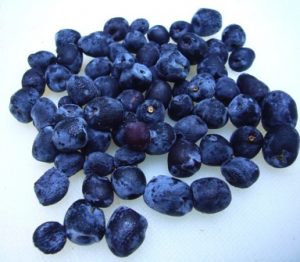
Podocarpus arils. We do not eat the seed. Photo by Green Deane
As mentioned a couple of weeks ago Podocarpus will be coming into full season soon. In my foraging classes we are finding a few ripe arils here and there. They are tasty and quite grape-like. Locally hedge-Podocarpus tend to be in season in August. Occasionally there is a Podocarpus tree that ripens in December (a different species I presume.) The shrub is in season for a month or more. Look for them in landscaping around homes, churches, and college campuses. They are also edible when they look like raisins (don’t forget to throw away the seed on the end. We don’t eat that.) To read more about them go here, for a video, here.

Foraging Classes are held rain or shine or cold.
Covid prevented my classes in South Carolina last year so we’re looking for good attendance this year. And later this month I have classes from Melbourne to Sarasota to Port Orange.
Saturday July 17th, Classes at 9 a.m. and 1 p.m at Putney Farm, 1624 Taylor Rd, Honea Path, SC 29654. To preregister email me at GreenDeane@gmail.com or putneyfarm@aol.com. Walk-ins welcomed. These classes are $20 for adults, children free.
Sunday July 18th, Classes at 9 a.m. and 1 p.m at Putney Farm, 1624 Taylor Rd, Honea Path, SC 29654. To preregister email me at GreenDeane@gmail.com or putneyfarm@aol.com. Walk-ins welcomed. These classes are $20 for adults, children free.
Saturday July 24th, Red Bug Slough Preserve, 5200 Beneva Road, Sarasota, FL, 34233, 9 a.m. to noon. Meet by the parking lot.
Sunay July 25th Wickham Park: 2500 Parkway Drive, Melbourne, FL 32935-2335. Meet at the “dog park” inside the park, 9 a.m. to noon.
Saturday July 31 George LeStrange Preserve, 4911 Ralls Road, Fort Pierce, FL, 34981, 9 a.m. to noon.
Sunday August 1st, Mead Garden: 1500 S. Denning Dr., Winter Park, FL 32789. Meet at the bathrooms. 9 a.m. to noon. Entrance to the park is on Denning. Some GPS get it wrong.
Saturday August 7th, Spruce Creek Park, 6250 Ridgewood Ave. Port Orange, 32127. Meet at the pavilion, 9 a.m. to noon.
For more information, to sign up or prepay, go here.
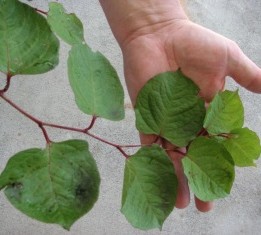
Japanese Knotweed. Photo by Green Deane
I am not sure it was with interest or amusement when I read about the Olympic Knotweed Working Group in Port Hadlock, Washington state. They have a knotweed problem that requires organization to combat it. That reminded me of the the Olympic stadium virtually half way around the world in London. It was a site of knotweed infestation and under British law the soil had to be removed and dealt with severely. That added 70 million pounds to the cost of building that stadium. That’s way in excess of $100 million dollars. Knotweed can break up concrete so it really had to be removed completely where the stadium was built. In Washington state there’s was an on-going study of how various herbicides and their application can kill of this edible weed. It’s fairly common in cooler climates and I’ve see a lot of it in the Carolinas. If I remember correctly it is also a commercial source of the anti-oxidant resveratrol. If you want to know more about knotweed click here.
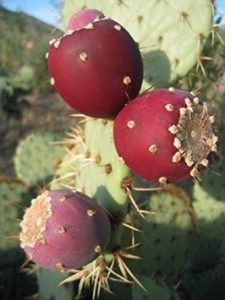
Fruit pulp tastes like raspberries.
In both foraging classes this past weekend we ate raw cactus. As we didn’t have a fire to burn the glochid off either the pads or fruit I cut them off which always leaves a few in my fingers or clothes. I can verify they itch for a few days. Cactus are native to 46 states excluding Hawaii, Maine, New Hampshire and Vermont — the farthest away from their origin in central America. They are native to southern Alaska and parts of Canada. Cactus have been naturalized in many parts of the world. Malta comes to mind where they are living fences and a “traditional” source of wine and spirits even though they are native to Mexico and southward. They used to be mostly in one genus, Opuntia but now are in Opuntia and Nopales.
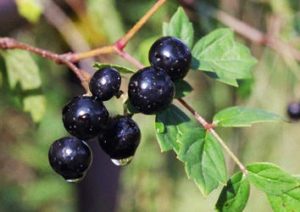
Peppervine is an iffy edible. Photo by Green Deane
Putting on black fruit now is the controversial Pepper Vine, Ampelopsis arborea. It is closely related to the edible grape but also closely related to the toxic Virginia Creeper. It’s one of those plants that some folks say is definitely toxic and others say definitely edible. My personal experience is that it is not edible but I know some credible foragers who say they have eating the ripe berries for a long time with no issue. No doubt the problem has to do with annual calcium oxalate production. In small amounts it’s tolerable. In higher concentrations it can cause skin problems or internally upset digestion. Pepper Vine (so-called because the fruit can give a pepper-like burn) apparently can make little to a lot of the chemical each year, varying greatly. Another possibility is method of preparation. Some people juice the berries and let the juice sit in the refrigerator which allows the acid to precipitate. The juice is then carefully decanted through two coffee filters and used. If you do so proceed with caution. The other caution is that Pepper Vine and Wild Grapes can grow intertwined and you can get some Pepper Vine fruit in with your grapes. This also can happen with Virginia Creeper. Pick your grapes carefully.

Green Deane videos are now available on a USB.
My nine-DVD set of 135 videos has been phased out and replaced by a 150-video USB. The USB videos are the same videos I have on You Tube. Some people like to have their own copy. The USB videos have to be copied to your computer to play. If you want to order the USB go to the DVD/USB order button on the top right of this page. That will take you to an order form. I’d like to thank all of you who ordered the DVD set over the years which required me to burn over 5,000 DVDs individually.

Green Deane Forum
Want to identify a plant? Perhaps you’re looking for a foraging reference? You might have a UFO, an Unidentified Flowering Object, you want identified. On the Green Deane Forum we — including Green Deane and others from around the world — chat about foraging all year. And it’s not just about warm-weather plants or just North American flora. Many nations share common weeds so there’s a lot to talk. There’s also more than weeds. The reference section has information for foraging around the world. There are also articles on food preservation, and forgotten skills from making bows to fermenting food. 
Your donations to upgrade the EatTheWeeds website and fund a book were appreciated. A book manuscript has been turned it. It had 425 articles, 1326 plants and a third of a million words. What it will be when the publisher is done with it next year is unknown. It will be published in the spring of 2023. Writing it took a significant chunk of time out of my life from which I have still not recovered. (Many things got put off.) The next phase is to update all the content on the website between now and publication date. Also note as it states above the 135-video DVD set has been phased out for 150-video USB. Times and formats change. Which reminds me I need to revisit many plants and make some new videos.
This is weekly newsletter #465. If you want to subscribe to this free newsletter you can find the sign-up form in the menu at the top of the page.
To donate to the Green Deane Newsletter click here.

